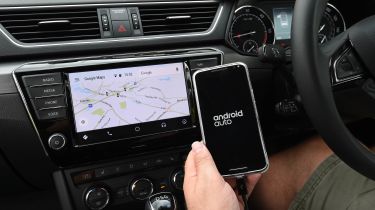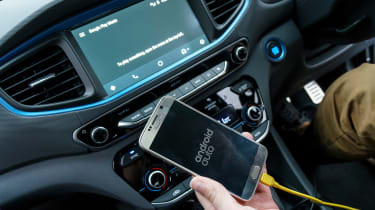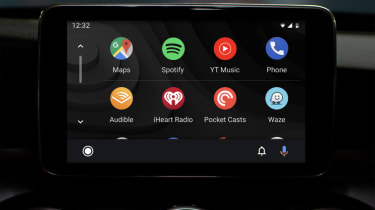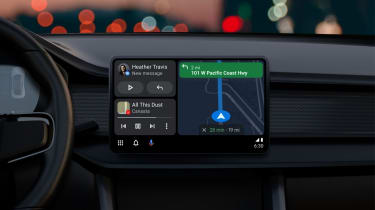What is Android Auto? Full review and user guide
We explain everything you need to know about Google's Android Auto software
Android Auto is Google’s own software for connecting and using your Android smartphone via a car’s infotainment system. Not only does Android Auto mirror your phone’s screen on the car’s dashboard, but it allows access to multiple apps, such as navigation, music and messaging, in a much easier and safer way when driving.
The vast majority of new cars now come with Android Auto as standard, as well as Apple CarPlay, its main rival. A key advantage of using Android Auto rather than a manufacturer’s own infotainment software is that it receives frequent over-the-air updates. These allow crucial apps to remain fully up-to-date as well as fixing any bugs in the system. Many cars can receive over-the-air updates, too, but changes to the infotainment systems tend to be a lot less frequent.
Android Auto adds plenty of extra functionality to many infotainment systems, too, as it allows text messages to be read or replied to, phone calls to be taken, and music streaming from third-party apps like Spotify or YouTube Music, all while on the move.
So how does Android Work, and what are the benefits and key features? We explain everything you need to know right here.
What is Android Auto?
Android Auto is a piece of software that connects Android phones to compatible infotainment systems, displaying a simplified version of your phone screen on your car’s dashboard touchscreen and allowing you to use some of the key features of your phone while on the move. This includes reading text messages, making calls, streaming music or navigating using apps such as Google Maps or Waze. Many other third party apps are also available including WhatsApp, Spotify and BBC Sounds.
The majority of new cars on sale today offer Android Auto compatibility either as standard or as an optional extra. If you find a car that doesn't, or you own an older model, there are numerous aftermarket car stereo head units that can add Android Auto to older cars. You can check compatibility on the Android website.
How to connect Android Auto
There are two ways to connect your phone to Android Auto, and both of them are very straightforward. Whichever approach you choose, though, will require an active mobile data or wi-fi connection. Here’s how to connect to Android Auto:
Connecting Android Auto with USB:
Unlock your phone, plug a USB or USB-C cable into it, and then insert the other end into the car’s USB or USB-C port (some cars may have a dedicated socket for data use). Once connected, instructions will appear on your car’s screen and give you the option to connect.
Connecting Android Auto wirelessly:
Some newer cars have the option to connect to Android Auto wirelessly. If you wish to do this, you can pair your phone via Bluetooth. Make sure your phone is discoverable and that your car’s infotainment system is set to allow devices to pair to it. Once these are ready to go, search for your car on the ‘found devices’ list on your phone and connect to it.
If you’re connecting a phone for the first time, most systems will ask you to check a four-digit code on both screens to ensure that you are connecting to the correct car. Once this is confirmed, you will be connected to Android Auto.
Once connected, Android Auto should load up automatically. If it fails to do so, there could be an issue with your connection, infotainment system or your phone’s compatibility.
Is my phone compatible with Android Auto?
In most cases, any Android phone running Android 6.0 or above will be compatible with Android Auto. However, any older smartphones running Android 9 or below will require the Android Auto app, but this is free to download from the Google Play Store.
If your device is running Android Auto but you get a blank screen on your car’s infotainment system, it may need a software upgrade or not be compatible at all.
What are the main features of Android Auto?
Interacting with Android Auto is predominantly done through your car’s infotainment screen, but manufacturers are increasing the scope of Android Auto through to the digital dashboard too. Some Android Auto features are also available through physical buttons, knobs or dials that control your car’s screen.
Android Auto’s user interface system creates on-screen tiles for different apps and shortcuts to speed up replies and phone calls. This was designed to improve the usability of the system and put more information in view at one time. This system has the ability to automatically adjust the interface's aspect ratio to accommodate portrait, landscape and widescreen infotainment systems and head units.
Google’s digital car key technology also allows users to share digital keys with contacts, giving them permission to drive the car without a physical key. This feature is only available on selected phones and cars, though.
Maps and navigation
One of the most impressive features of Android Auto is Google Maps, which brings detailed navigation and real-time traffic information to your car. The display is quick to respond, it constantly looks for quicker route options and best of all, you can just click a microphone button and say, ‘Navigate to’ any given destination and it’ll take you there. The recognition can be fooled by background tyre roar if you’re travelling along a particularly noisy stretch of road - but that aside, it’s uncannily accurate.
Using Google’s data, Maps provides more information about commercial destinations instead of just streets and postcodes. And being Google, it also has access to your recent browsing and search history - so it’s possible to look for a future destination at your office desk or home laptop, jump into the car, hook up your phone and find it suggested as a possible route to you without even asking for it.
Real-time traffic information is based on Google’s other navigation users data, so is much more accurate than pre-installed manufacturers’ radio- and camera-based data. The system is also able to suggest quicker routes and provide information on traffic problems or roadworks. Other navigation apps like Waze are also supported.
Music streaming
Android Auto also allows you to access your preferred music streaming apps. All big subscription-based services like Amazon Music, Youtube Music and Spotify are all compatible. We’ve tried Spotify with a premium account and it’s reasonably slick, showing album art and using Google’s cloud-based speech recognition to allow you to demand any track from the archive - regardless of whether it’s in your collection or not.
‘Browsing’ for new music or through playlists is quite restrictive, presumably for safety reasons. Even though your Spotify library may have 100 albums or artists, you’re only ever able to scroll through eight or 10 of them before you get a pop-up telling you to pause scrolling before you continue to browse. Apple’s CarPlay system - which offers many of Android Auto’s features on iOS devices - isn’t as strict.
There are also dozens of eBooks and Podcast apps on offer - although you may need to use trial and error to find one with the right mix of content and a user-friendly interface.
Third party apps
Third party apps like WhatsApp and Skype are also compatible, allowing you to potentially use those services to make VOIP calls instead of Android Auto’s conventional smartphone system.
Bizarrely, phone access is one of Android Auto’s weaker points. It’s basically sound, and it will read out texts or WhatsApp messages to you and allow you to dictate replies - but it’s not much more comprehensive than a decent car-smartphone interface. At least the fact that it’s contained within Android Auto’s on-screen environment means that you don’t have to hop back out to the car’s own system to make a phone call. You do have to do this to switch radio stations or media if you’re not listening to music through an Android Auto streaming app, though.
Android Auto updates
One of the big advantages to Android Auto is its regular updates. While modern cars do receive over-the-air updates to their operating systems, they are rarely comprehensive and this isn’t even possible on older models. Android Auto has been updated regularly over the years with significant improvements to features and functionality.
Which car manufacturers support Android Auto?
Today, Android Auto is avaialble in the vast majority of brand-new cars from virtually every major manufacturer, as well as several smaller brands.
It’s worth remembering, though that Android Auto is optional on some models. You’ll need to study the standard equipment list and the options section of the brochure pretty carefully to make sure you can definitely get hooked up.
How can I get Android Auto in my car?
As we’ve seen, a significant majority of brand-new cars now come with Android Auto as a standard feature, although you may have to pay a little extra for it in some cases. If you have an older or classic car with an outdated head unit or no infotainment system at all, there are plenty of aftermarket stereos and touchscreens which will allow you to connect your phone via Android Auto.
How is Android Auto different from just using my phone?
The biggest difference is that the system has been developed with car use in mind, and as a result, it is easier to use Android Auto while driving than faffing about with a phone that is in a cradle or stuck to the dash. Remember it is illegal to use a hand held phone when driving.
Also, to help reduce frustration with missing buttons and avoid taking your eyes off the road, Google’s Assistant speech recognition software allows you to take command of the majority of Android Auto features, again helping drivers use the software on the move. You can also use the car’s buttons and even its steering wheel controls to access features such as voice activation and track selection, or even activate it by simply saying “Hey Google”.
What is the difference between Android Auto and Android Automotive?
Android Auto compatibility has become very widely available on new cars, however, one of its main advantages has been diluted in recent times as modern cars are increasingly connected to the Internet and able to receive over-the-air software updates. Of course, Google wasn't about to get left behind by the march of technology and it worked with car makers including Audi and Volvo to create Android Automotive.
Whereas Android Auto is a smartphone app that can be paired with a compatible car, Android Automotive is Google's native in-car infotainment software. It gives you a full suite of Google services and apps including Google Maps navigation, Google Play app store and Google Assistant voice control in the car with no need to pair your phone.
The similarity of the Android Auto and Android Automotive names can cause a little confusion but there is an important distinction even though the actual user interface is similar. Android Automotive is currently installed on various new models from Volvo, Polestar and Renault with each manufacturer incorporating design changes to the system so it matches brand identity.
How much does Android Auto cost?
Android Auto is free to use and comes as standard in many cars. However, it's worth remembering that while pairing with your car is free, Android Auto is a data-heavy service, so any dropouts in phone signal will eat into the data allowance on your mobile phone contract.
If you have to pay for your data, you may be charged extra by your mobile phone service provider, and these charges may be higher while travelling abroad. It may be possible to avoid using as much data by downloading maps for the area before you set off on the trip, and the same goes for your favourite media such as music and podcasts.
In addition, while there are many excellent free apps that support Android Auto, you may find that some other services, including music streaming, are better if you pay for a subscription.
Do you have Android Auto in your car? Tell us what you think of it in the comments section below...









